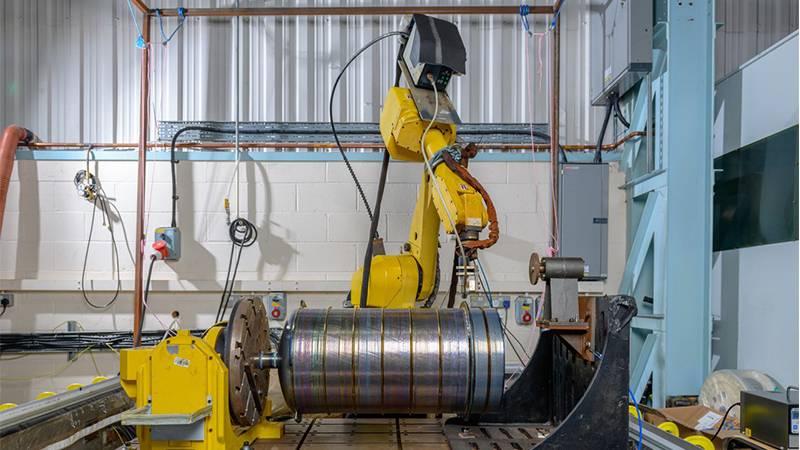A team comprising of Thales Alenia Space, Cranfield University and Glenalmond Technologies have successfully produced a first full-scale prototype of a titanium pressure vessel to be used in future manned missions for space exploration.
The piece is approximately 1m in height and 8.5kg in mass. Made of the titanium alloy (Ti-6Al-4V), it has been deposited using the Wire + Arc Additive Manufacturing (WAAM) process, which Cranfield University has pioneered over the last decade.
Thanks to being able to go straight from digital drawing to final structure, WAAM has integrated two individual pieces into a single part; eliminating the need for long-lead-time forgings; and substantially reduced the amount of waste material removed by machining.
If manufactured traditionally, the component would have required about 30 times more raw material than its final mass. By using the WAAM process, more than more than 200 kg of Ti-6Al-4V has been saved for each item. There is room to improve this further, and Cranfield is working on innovative methods to deposit closer to the final thickness.
The WAAM shape was manufactured at Cranfield and then sent to Glenalmond Technologies where it was stress-relieved, laser-scanned, machined and inspected using an ultrasonic method. The final inspection was performed by Agiometrix using a computer tomography (CT-scan) for internal quality analysis and an optical scanner, with Thales Alenia Space ensuring that the part met the mechanical requirements and specifications.
Following the checks, the project team is satisfied that the vessel fulfils the driving technical and quality requirements. The team is now proceeding to the building of a second prototype, with the purpose to carry out a fine tuning of the whole manufacturing cycle, to demonstrate the repeatability and reliability of the process, and to push the implementation of the new approach into the flight hardware.
Eng. Massimo Chiampi, Study Manager for Additive Manufacturing projects at Thales Alenia Space, said: “We were looking for an innovative manufacturing solution for the tanks, which typically suffer from long lead time with the conventional production route based on subtractive machining. Thanks to this project, we have demonstrated that the adoption of WAAM technology enhances the competitiveness of our product. A near-net-shape item is fabricated in few days – compared to several months needed for the procurement of the standard wrought products – and also the amount of machining operation is consistently reduced. We have achieved a 65% reduction on the overall lead time without giving up the requested performances and this provides a benefit also in terms of design flexibility, making it possible to answer customer needs at a late stage of the project.”
Dr Jialuo Ding, Principal Research Fellow at Cranfield University and Chief Scientist at WAAM3D, said: “We have been developing WAAM technology for more than 10 years and it is very satisfying to see it reach this level of commercial maturity. We are very excited about rolling out the technology through our new spinout company, WAAM3D. We are also extremely pleased with the work done by Glenalmond Technologies, who have dealt with a part with limited machining stock, perfectly and at their first attempt.”
Dr Filomeno Martina, Senior Lecturer at Cranfield University and CEO of WAAM3D, said: “This part was built using software and hardware that has been developed over the last decade; these are finally ready for commercialisation through a new spin-out company from Cranfield, WAAM3D. This part has given us the opportunity to test WAAM3D’s innovative solutions on a high-profile user case, with a very aggressive timescale. We are very proud of the level of automation achieved at Cranfield University. WAAM3D will make all these tools available to industrial community in the next couple of months and we are looking forward to the impact on industrial large-scale additive manufacture this will have.”
Source: Cranfield University


